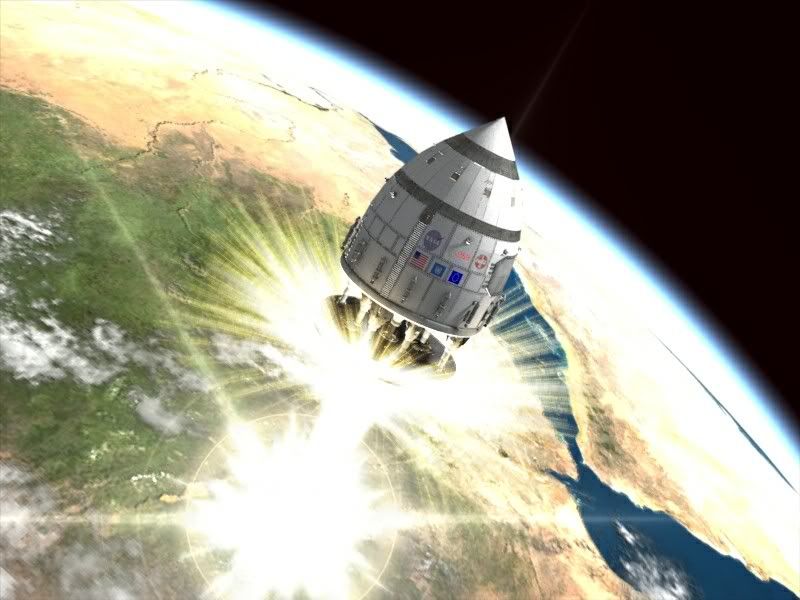How many people have SOLIDS killed in the U.S. program? Think Challenger.Uh, you might want to rethink that. It was the External Tank blowing (the chemicals) which destroyed the Orbiter and the crew cabin. The SRB had a flaw, and was operated outside its design parameters. It has since been fixed, and the parameters of operation adjusted to further enhance safety.
Meantime, the next major failure was caused by the insulation system failure (insulation necessary for a cryogenically-cooled liquid fuel rocket system) destroying the integrity of the TPS Thermal Protection System of the of Orbiter Columbia.
Hence, it could be just as reasonably be said that liquid fuels caused BOTH losses of the Shuttles Challenger and Columbia.
As I recall the original idea was that NERVA would be the Moon rocket, later was relegated to an upper-stage concept. I recall reading in Analog about more advanced designs for more powerful nuclear rockets. NASA was apparently toying with the idea at least in 2001 of an Earth-to-orbit nuclear rocket.
http://www.newscientist.com/article.ns?id=dn972
NASA considers nuclear boosters for space rockets
11:30 05 July 2001
From New Scientist Print Edition. Subscribe and get 4 free issues.
NASA is thinking about using nuclear boosters to lift rockets into orbit at a fraction of the cost of today's all-chemical launchers.
The agency hopes the public will be less resistant to nuclear-assisted rockets now that the Bush administration is considering a return to nuclear power. But anti-nuclear protesters claim nuclear launchers would make accidents much more damaging and accuse NASA of "playing Russian roulette".
NASA is keen to move away from conventional chemical rockets to lighter, more powerful propulsion systems. "We've taken chemical rockets pretty close to as far as we can," says Robert Adams of NASA's Marshall Space Flight Center in Alabama.
"Nuclear systems give you a chance to reduce your mass and so your overall costs to orbit," Adams says. Nuclear propulsion could allow single-stage rockets to reach orbit - cutting the need for expendable boosters and allowing what he calls "airline-like" access to space.
High flyer
Adams will describe conceptual plans for a "nuclear-enhanced air-breathing rocket" at a meeting of the American Institute of Aeronautics and Astronautics in Salt Lake City, Utah, next week. A uranium dioxide fission reactor will heat hydrogen from an on-board tank to 2500 °C. The hot hydrogen will then be mixed with air from outside the rocket and combusted at almost 4000 °C.
After lift-off, a chemical rocket would first be used to accelerate the rocket to Mach 2, before the nuclear engine was triggered. "You wouldn't fire this reactor up until we got about 30,000 feet off the ground," he says.
Adams's calculations show that a nuclear-assisted rocket could produce far more thrust than conventional rockets. It would also be lighter and be able to lift a bigger fraction of its starting mass into orbit - perhaps as much as 45 per cent. "With existing systems, it's more like 10 per cent," he says.
Whether the rockets will ever be safe enough to carry astronauts is not yet clear. "We'd have to do a lot more calculations on the radiation side of things," says Adams.
Plutonium power
Nuclear generators have been used before to provide electricity on board spacecraft such as the Cassini probe which is on its way to Saturn. But these generators don't use fission reactions, they simply use the heat generated by a lump of radioactive plutonium to produce electricity.
Even so, Cassini and other plutonium-carrying probes have drawn criticism from anti-nuclear protesters fearful of nuclear fallout if the rocket exploded on the launch pad or during its ascent.
But a change in public attitude towards nuclear power would take the heat off NASA, says George Schmidt, deputy manager of the Propulsion Research Center at Marshall.
"It really requires an education of the public," he says. "If there's an enhancement of understanding about what nuclear is about, we can benefit from that."
"A matter of time"
But the worries won't disappear, says George Maise, an aeronautical engineer who works on nuclear-assisted rockets for Plus Ultra Technologies in Stony Brook, New York.
"There are some legitimate safety and environmental issues if the spacecraft were to crash during launch," he says. Triggering the reactor in the atmosphere could also be a problem. "The idea of deliberately releasing fission products into the atmosphere, even in negligible amounts, is going to be a very hard sell."
Bruce Gagnon of the Global Network Against Weapons and Nuclear Power in Space, which organised protests against Cassini, isn't reassured. "It's just a matter of time before there's an accident," he says.



